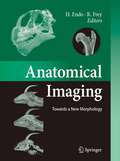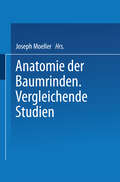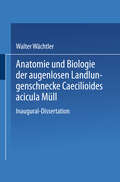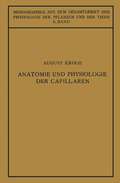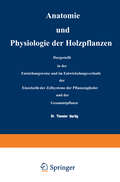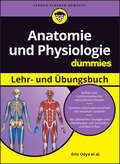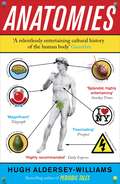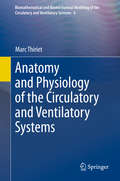- Table View
- List View
Anatomical Adaptations of Halophytes: A Review of Classic Literature and Recent Findings
by Marius-Nicușor Grigore Constantin TomaThis book describes important anatomical adaptations in halophytes, based on a large review of relevant literature (since the 17th century) and recent research findings. Scientists involved in the study of plant biology, from a molecular to ecosystemic level, will find information about all major structural strategies of salt tolerant plants. The book starts with an introductory theoretical background, where several aspects related to the definition and classification of halophytes and saline environments are included. Major anatomical adaptations are then grouped around major concepts: succulence, tracheoidioblasts, salt secretion, Kranz anatomy, successive cambia, and bulliform cells. Each of them is treated following a general scheme: introductory considerations, anatomical basis, and ecological implications; a review of relevant literature is then conducted and the text is supported by a large number of figures, especially ink drawings and color micrographs.
Anatomical Imaging: Towards a New Morphology
by Hideki Endo Roland FreyThis book presents selected works of contemporary evolutionary morphologists and includes such topics as broad scale reconstructions of the brain and ear of dinosaurs, inference of locomotor habits from cancellous bone architecture in fossil primates, and a comparison of the independently evolved manipulating apparatuses in the lesser and giant pandas. Insight is provided into the application of modern noninvasive technologies, including digital imaging techniques and virtual 3D reconstruction, to the investigation of complex anatomical features and coherences. In combination with traditional methods, this allows for the formulation of improved hypotheses on coordinated function and evolution. The creation of virtual translucent specimens makes it possible to realize the age-old dream of the classical anatomists: looking through the skin into the inner organization of an organism. On full display here is the dramatic and promising impact that modern imaging techniques have on scientific progress in evolutionary morphology.
Anatomical Terms (UEB Contracted)
by RnibThis is a labelled four-page document showing the anatomical views and planes of movement of the human body. There is a locator dot shown, which will be at the top left of the page when the image is the correct way up. The diagrams are as follows: - Anatomical terms front view - Anatomical terms side view - Planes of movement body planes (front view) - Planes of movement body planes (side view)
Anatomie der Sehrinde (Monographien aus dem Gesamtgebiete der Neurologie und Psychiatrie #64)
by Max de CrinisDieser Buchtitel ist Teil des Digitalisierungsprojekts Springer Book Archives mit Publikationen, die seit den Anfängen des Verlags von 1842 erschienen sind. Der Verlag stellt mit diesem Archiv Quellen für die historische wie auch die disziplingeschichtliche Forschung zur Verfügung, die jeweils im historischen Kontext betrachtet werden müssen. Dieser Titel erschien in der Zeit vor 1945 und wird daher in seiner zeittypischen politisch-ideologischen Ausrichtung vom Verlag nicht beworben.
Anatomie für die mündliche Prüfung: Fragen und Antworten (MEDialog)
by Gunther WennemuthDie Reihe MEDialog wurde zur effizienten Vorbereitung auf die mündliche Prüfung im Physikum konzipiert. Etwa 180 Fragen decken sämtliche Inhalte des Gegenstandskatalogs im Fach Anatomie ab. Jeder Antwort ist eine Seite gewidmet. Wo immer möglich, wird dabei auf die klinische Relevanz des betreffenden Sachverhalts eingegangen. In den Antworttext integrierte Abbildungen erleichtern das Verständnis komplexer Aspekte. Diese Form der Darstellung garantiert, daß man die Fakten und Zusammenhänge im Fach Anatomie auch kurz vor der mündlichen Prüfung noch einmal rekapitulieren kann. MEDialog eignet sich nicht nur zum "Solo-Lernen", sondern auch für die Lerngruppe. Denn gerade im Dialog mit anderen kann die mündliche Prüfungssituation effektiv simuliert werden.
Anatomie für die mündliche Prüfung: Fragen und Antworten (MEDialog)
by Gunther WennemuthDie Reihe MEDialog wurde zur effizienten Vorbereitung auf die mündliche Prüfung im Physikum konzipiert. Etwa 180 Fragen decken sämtliche Inhalte des Gegenstandskatalogs im Fach Anatomie ab. Jeder Antwort ist eine Seite gewidmet. Wo immer möglich, wird dabei auf die klinische Relevanz des betreffenden Sachverhalts eingegangen. Zum Abschluss geben "IMPP Fakten" in extrem komprimierter Form die Prüfungsinhalte der letzten Examina wieder. Diese Form der Darstellung garantiert, dass man die Fakten und Zusammenhänge im Fach Anatomie auch kurz vor der mündlichen Prüfung noch einmal rekapitulieren kann. MEDialog eignet sich nicht nur zum "Solo-Lernen", sondern auch für die Lerngruppe. Denn gerade im Dialog mit anderen kann die mündliche Prüfungssituation effektiv simuliert werden.
Anatomie kompakt für Dummies (Für Dummies)
by Donna Rae SiegfriedSie suchen einen kompakten und leicht verständlichen Einstieg in die Anatomie des Menschen? Dann haben wir hier genau das richtige Buch für Sie! Donna Rae Siegfried erklärt Ihnen alles Wichtige zum Aufbau des menschlichen Körpers. Sie erfahren, wie Skelett, Muskeln und Haut aufgebaut sind, wie Nerven-, Kreislauf-, Lymph-, Exkretions- und Reproduktionssystem strukturiert sind, wie Atmungs- und Verdauungsapparat organisiert sind und vieles mehr. So ist dies Ihr perfekter Nachhilfelehrer für die Tasche: freundlich, kompetent und günstig.
Anatomie kompakt für Dummies (Für Dummies)
by Donna Rae SiegfriedSie suchen einen kompakten und leicht verständlichen Einstieg in die Anatomie des Menschen? Dann haben wir hier genau das richtige Buch für Sie! Donna Rae Siegfried erklärt Ihnen alles Wichtige zum Aufbau des menschlichen Körpers. Sie erfahren, wie Skelett, Muskeln und Haut aufgebaut sind, wie Nerven-, Kreislauf-, Lymph-, Exkretions- und Reproduktionssystem strukturiert sind, wie Atmungs- und Verdauungsapparat organisiert sind und vieles mehr. So ist dies Ihr perfekter Nachhilfelehrer für die Tasche: freundlich, kompetent und günstig.
Anatomie und Biologie der augenlosen Landlungenschnecke Caecilioides acicula Müll
by Walter WächtlerDieser Buchtitel ist Teil des Digitalisierungsprojekts Springer Book Archives mit Publikationen, die seit den Anfängen des Verlags von 1842 erschienen sind. Der Verlag stellt mit diesem Archiv Quellen für die historische wie auch die disziplingeschichtliche Forschung zur Verfügung, die jeweils im historischen Kontext betrachtet werden müssen. Dieser Titel erschien in der Zeit vor 1945 und wird daher in seiner zeittypischen politisch-ideologischen Ausrichtung vom Verlag nicht beworben.
Anatomie und Embryologie (Handbuch der Urologie Encyclopedia of Urology Encyclopedie d'Urologie #1)
by Klaus Conrad H. Ferner A. Gisel H.v. Hayek W. Krause S. Wieser C. ZakiAnatomie und Pathologie der Spontanerkrankungen der kleinen Laboratoriumstiere
by Rudolf JaffeDieser Buchtitel ist Teil des Digitalisierungsprojekts Springer Book Archives mit Publikationen, die seit den Anfängen des Verlags von 1842 erschienen sind. Der Verlag stellt mit diesem Archiv Quellen für die historische wie auch die disziplingeschichtliche Forschung zur Verfügung, die jeweils im historischen Kontext betrachtet werden müssen. Dieser Titel erschien in der Zeit vor 1945 und wird daher in seiner zeittypischen politisch-ideologischen Ausrichtung vom Verlag nicht beworben.
Anatomie und Physiologie der Capillaren (Monographien aus dem Gesamtgebiet der Physiologie der Pflanzen und der Tiere #5 )
by August Krogh Ulrich EbbeckeDieser Buchtitel ist Teil des Digitalisierungsprojekts Springer Book Archives mit Publikationen, die seit den Anfängen des Verlags von 1842 erschienen sind. Der Verlag stellt mit diesem Archiv Quellen für die historische wie auch die disziplingeschichtliche Forschung zur Verfügung, die jeweils im historischen Kontext betrachtet werden müssen. Dieser Titel erschien in der Zeit vor 1945 und wird daher in seiner zeittypischen politisch-ideologischen Ausrichtung vom Verlag nicht beworben.
Anatomie und Physiologie der Holzpflanzen: Dargestellt in der Entstehungsweise und im Entwickelungsverlaufe der Einzelzelle, der Zellsysteme, der Pflanzenglieder und der Gesammtpflanze
by NA HartigAnatomie und Physiologie für Dummies (Für Dummies)
by Erin Odya Maggie A. NorrisDer menschliche Körper ist ein komplexes System, in dem viele unterschiedliche Strukturen zusammenwirken. Erin Odva und Maggie Norris zeigen in diesem farbig illustrierten Band, was den menschlichen Körper ausmacht, wie unterschiedliche Systeme zusammenarbeiten und wie der Körper als großes Ganzes funktioniert. Erfahren Sie alles über Knochen, Muskeln, Hormone, das Nervensystem und vieles mehr. Wie man es von den Dummies nicht anders kennt, werden die Leser locker, leicht und mit einer Prise Humor in das komplexe Thema eingeführt.
Anatomie und Physiologie Lehr- und Übungsbuch für Dummies (Für Dummies)
by Erin Odya Donna Rae Siegfried Janet Rae-Dupree Pat DuPreeIhr Fahrplan für den menschlichen Körper Ergründen Sie den menschlichen Körper und seine Funktionsweise! Die Fächer Anatomie und Physiologie sind komplex, aber mit der richtigen Herangehensweise beherrschen Sie diese spannenden Themen im Nu. Der Schlüssel zum Erfolg heißt: erst verstehen und dann durch Üben nachhaltig einprägen. Dieses farbig illustrier-te Lehr- und Übungsbuch zeigt Ihnen, wie die unterschiedlichen Systeme des Körpers zusammenarbeiten. Sie erfahren alles über Organe, Knochen, Muskeln, Zellen, Hormone und vieles mehr. Mit Abbildungen zum Beschriften und Ausmalen sowie zahlreichen Übungsaufgaben ist die Prüfungsvorbereitung ganz einfach. Sie erfahren Wie Sie Knochen, Muskeln und Organe erkennen und lokalisieren Wie Kreislauf und Nerven-system funktionieren Was Sie über die Biochemie des Stoffwechsels wissen sollten Wie sich Krankheiten auf den Körper auswirken
Anatomies: The Human Body, Its Parts and The Stories They Tell
by Hugh Aldersey-WilliamsThe Sunday Times Science Book of the Year, Anatomies by Hugh Aldersey-Williams, author of bestseller Periodic Tales, is a splendidly entertaining journey through the art, science, literature and history of the human body.'Magnificent, inspired. He writes like a latter-day Montaigne. Stimulating scientific hypotheses, bold philosophic theories, illuminating quotations and curious facts. I recommend it to all' Telegraph *****'Splendid, highly entertaining, chock-full of insights ... It inserts fascinating scientific snippets and anecdotes about our organs into the wider history of our changing understanding of our bodies' Sunday Times'A relentlessly entertaining cultural history of the human body ... brims with fascinating details, infectious enthusiasm ... the terrain he covers is so richly brought to life' Guardian'Elegant and informative ... For Aldersey-Williams, [the body] is a thing of wonder and a repository of fascinating facts' Mail on Sunday ****In Anatomies, bestselling author Hugh Aldersey-Williams investigates that marvellous, mysterious form: the human body. Providing a treasure trove of surprising facts, remarkable stories and startling information drawn from across history, science, art and literature - from finger-prints to angel physiology, from Isaac Newton's death-mask to the afterlife of Einstein's brain - he explores our relationship with our bodies and investigates our changing attitudes to the extraordinary physical shell we inhabit.'More than a science book - it's also history, biography and autobiography - Anatomies is writing at its most refined, regardless of genre' Sunday TimesPraise for Periodic Tales:'Science writing at its best ... fascinating and beautiful ... if only chemistry had been like this at school ... to meander through the periodic table with him ... is like going round a zoo with Gerald Durrell ... a rich compilation of delicious tales, but it offers greater rewards, too' Matt Ridley'Immensely engaging and continually makes one sit up in surprise' Sunday Times'Splendid ... enjoyable and polished' Observer'Full of good stories and he knows how to tell them well ... an agreeable jumble of anecdote, reflection and information' Sunday Telegraph'Great fun to read and an endless fund of unlikely and improbable anecdotes ... sharp and often witty' Financial TimesHugh Aldersey-Williams studied natural sciences at Cambridge. He is the author of several books exploring science, design and architecture and has curated exhibitions at the Victoria and Albert Museum and the Wellcome Collection. His previous book Periodic Tales: The Curious Lives of the Elements was a Sunday Times bestseller and has been published in many languages around the world. He lives in Norfolk with his wife and son.
Anatomische und mykologische Untersuchungen über die Zersetzung und Konservierung des Rotbuchenholzes
by Johann TuzsonAnatomy, Age and Ecology of High Mountain Plants in Ladakh, the Western Himalaya
by Jiří Doležal Miroslav Dvorský Annett Börner Jan Wild Fritz Hans SchweingruberThis aesthetically unique book combines ecological, morphological and anatomical, as well as phylogenetic studies on plant material in a largely unexplored dry mountain region above the timberline. It offers the first comparative analysis of hundreds of plants - annuals, perennial herbs and dwarf shrubs - in an area of 87,000 km2 at altitudes from 2600 to 6150 m above sea level in the Western Himalaya. Characteristic landscape pictures of all major vegetation types and maps show at which locations and altitudes the individual species of vascular plants are distributed, while macroscopic plant pictures and plant age are related to high-quality micro-sections and micro-photographs. The anatomical features of 345 dicotyledons were characterized using the published coding systems and those of 155 monocotyledones were characterized on the basis of a newly developed key. The number of annual rings and anatomical features of the xylem and phloem of dicots are compared and related to different ecological conditions within this extremely dry and cold environment. The ecological and anatomical characterization is used to create a phylogenetic tree based on nucleotide sequences, and indicates which features are genetically stable and which ones are modified by environmental factors. The book appeals to scientists in the fields of plant taxonomy, morphology, anatomy and ecology.
Anatomy And Human Movement: Structure And Function (Physiotherapy Essentials Ser. (PDF))
by Nigel Palastanga Roger W. SoamesPrinted book plus PageburstT access - you will receive a printed book and access to the complete book content electronically. PageburstT enhances learning by not only bringing world class content to your fingertips but also letting you add to it, annotate it, and categorize it all in a way that suits you. PageburstT frees you to spend more time learning and less time searching. Over the past 22 years, Anatomy and Human Movement has grown into a classic textbook, helping students to understand and remember the mechanisms which allow movement to take place. Now in its sixth edition, the approach remains the same - each section of the body is presented systematically where readers are introduced to the bones, then guided through the muscles, joints , nervous system and blood supply. Anatomy of the musculoskeletal system is brought to life through simple full colour artwork following a colour key for clarity and accuracy.
Anatomy And Human Movement: Structure And Function (PDF) (Physiotherapy Essentials Ser.)
by Roger W. Soames Nigel Palastanga Richard TibbittsSince its first publication in 1989, Anatomy and Human Movement has grown to become a best-selling seminal textbook, helping students to understand and remember the mechanisms which allow movement to take place. Written specifically for physiotherapists and occupational therapists, this textbook is the ideal resource for students learning how to perform a musculoskeletal examination and for practising clinicians who need to refresh their functional anatomy.
Anatomy and Physiology For Dummies
by Erin Odya Maggie A. NorrisLearn about the human body from the inside out Some people think that knowing about what goes on inside the human body can sap life of its mystery—which is too bad for them. Anybody who's ever taken a peak under the hood knows that the human body, and all its various structures and functions, is a realm of awe-inspiring complexity and countless wonders. The dizzying dance of molecule, cell, tissue, organ, muscle, sinew, and bone that we call life can be a thing of breathtaking beauty and humbling perfection. Anatomy & Physiology For Dummies combines anatomical terminology and function so you'll learn not only names and terms but also gain an understanding of how the human body works. Whether you're a student, an aspiring medical, healthcare or fitness professional, or just someone who's curious about the human body and how it works, this book offers you a fun, easy way to get a handle on the basics of anatomy and physiology. Understand the meaning of terms in anatomy and physiology Get to know the body's anatomical structures—from head to toe Explore the body's systems and how they interact to keep us alive Gain insight into how the structures and systems function in sickness and health Written in plain English and packed with beautiful illustrations, Anatomy & Physiology For Dummies is your guide to a fantastic voyage of the human body.
Anatomy and Physiology For Dummies
by Erin Odya Maggie A. NorrisLearn about the human body from the inside out Some people think that knowing about what goes on inside the human body can sap life of its mystery—which is too bad for them. Anybody who's ever taken a peak under the hood knows that the human body, and all its various structures and functions, is a realm of awe-inspiring complexity and countless wonders. The dizzying dance of molecule, cell, tissue, organ, muscle, sinew, and bone that we call life can be a thing of breathtaking beauty and humbling perfection. Anatomy & Physiology For Dummies combines anatomical terminology and function so you'll learn not only names and terms but also gain an understanding of how the human body works. Whether you're a student, an aspiring medical, healthcare or fitness professional, or just someone who's curious about the human body and how it works, this book offers you a fun, easy way to get a handle on the basics of anatomy and physiology. Understand the meaning of terms in anatomy and physiology Get to know the body's anatomical structures—from head to toe Explore the body's systems and how they interact to keep us alive Gain insight into how the structures and systems function in sickness and health Written in plain English and packed with beautiful illustrations, Anatomy & Physiology For Dummies is your guide to a fantastic voyage of the human body.
Anatomy and Physiology for the Manual Therapies
by Andrew Kuntzman Gerard J. TortoraAnatomy & Physiology for the Manual Therapies 1e is designed to meet the specific needs of students preparing for careers in the manual therapies, such as massage therapy and careers as physical therapy assistants. This book provides the most appropriate depth of coverage for each body system -- in both narrative and visuals -- and by including relevant applications linking the content to situations they will face in their careers. Specially written applications with a focus on massage and physical therapy are included. An outstanding illustration program is also integrated to highlight important concepts and special diagrams are presented that point to origin, insertion, and innervation of muscles. This is crucial knowledge for massage therapists, physical therapists, and occupational therapists.
Anatomy and Physiology of the Circulatory and Ventilatory Systems (Biomathematical and Biomechanical Modeling of the Circulatory and Ventilatory Systems #6)
by Marc ThirietTogether, the volumes in this series present all of the data needed at various length scales for a multidisciplinary approach to modeling and simulation of flows in the cardiovascular and ventilatory systems, especially multiscale modeling and coupled simulations. The cardiovascular and respiratory systems are tightly coupled, as their primary function is to supply oxygen to, and remove carbon dioxide from, the body's cells. Because physiological conduits have deformable and reactive walls, macroscopic flow behavior and prediction must be coupled to nano- and microscopic events in a corrector scheme of regulated mechanism. Therefore, investigation of flows of blood and air in physiological conduits requires an understanding of the biology, chemistry, and physics of these systems, together with the mathematical tools to describe their functioning in quantitative terms. The present volume focuses on macroscopic aspects of the cardiovascular and respiratory systems in normal conditions, i.e., anatomy and physiology, as well as the acquisition and processing of medical images and physiological signals.

